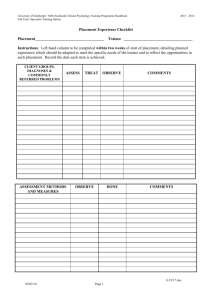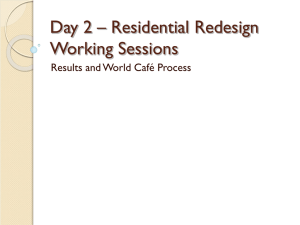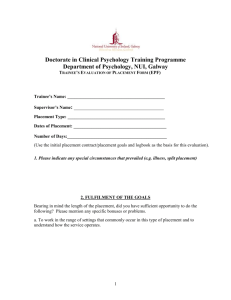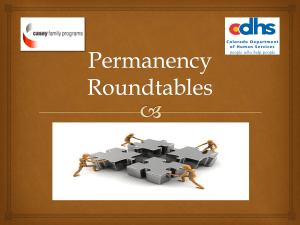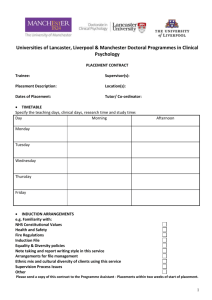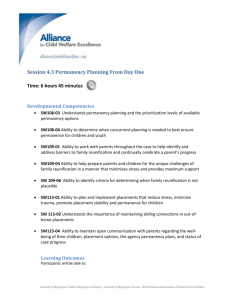Competencies and Learning Objectives (Tab 4)
advertisement
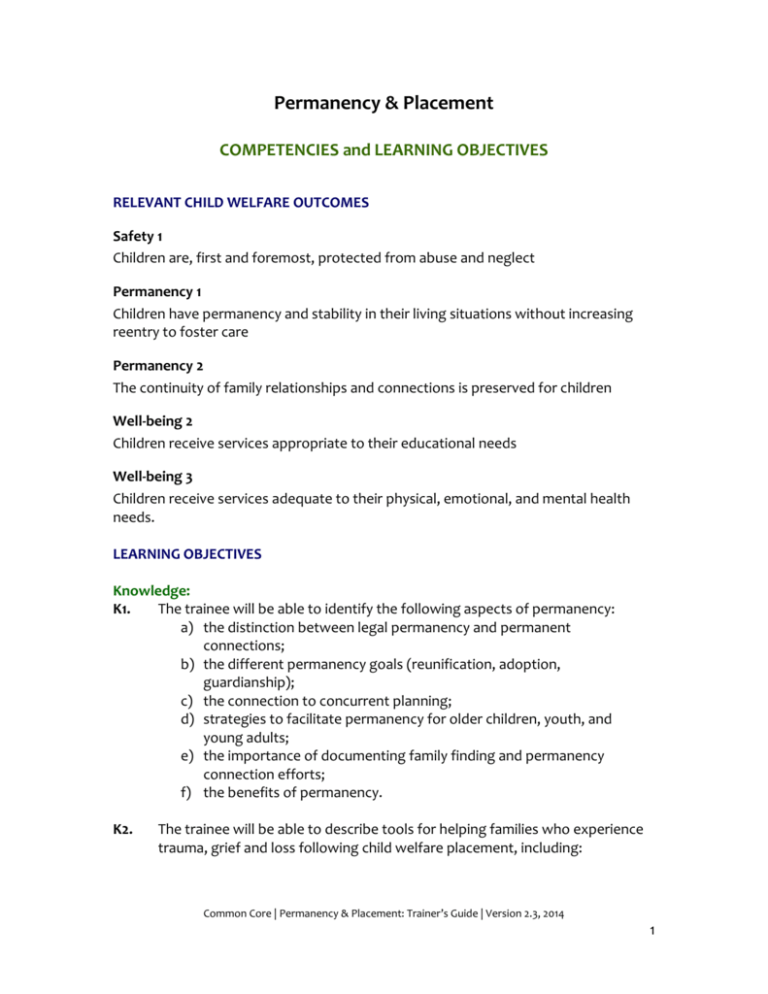
Permanency & Placement COMPETENCIES and LEARNING OBJECTIVES RELEVANT CHILD WELFARE OUTCOMES Safety 1 Children are, first and foremost, protected from abuse and neglect Permanency 1 Children have permanency and stability in their living situations without increasing reentry to foster care Permanency 2 The continuity of family relationships and connections is preserved for children Well-being 2 Children receive services appropriate to their educational needs Well-being 3 Children receive services adequate to their physical, emotional, and mental health needs. LEARNING OBJECTIVES Knowledge: K1. The trainee will be able to identify the following aspects of permanency: a) the distinction between legal permanency and permanent connections; b) the different permanency goals (reunification, adoption, guardianship); c) the connection to concurrent planning; d) strategies to facilitate permanency for older children, youth, and young adults; e) the importance of documenting family finding and permanency connection efforts; f) the benefits of permanency. K2. The trainee will be able to describe tools for helping families who experience trauma, grief and loss following child welfare placement, including: Common Core | Permanency & Placement: Trainer’s Guide | Version 2.3, 2014 1 a) identifying behaviors that indicate separation trauma in children, youth, and young adults of different developmental stages and of different cultural backgrounds; b) identifying engagement strategies to assist children, youth and adults to engage in collaborative mental health assessment and treatment to address their feelings of grief and loss related to placement; and c) identifying strategies including collaborating with mental health service providers to promote attachment for infants, children, youth, and young adults in placement. K3. The trainee will be able to identify the principles of concurrent planning as defined in PL 96-272 and key steps for successful concurrent planning. K4. The trainee will be able to identify cultural factors that affect: a) children and youth in their adjustment to out of home care; b) the interaction between families of origin and substitute care providers; c) transition planning d) concurrent planning; e) permanency options. K5. The trainee will be able to recognize the key elements of public policy, federal laws, California laws, and regulations specific to children and youth placed in out-of-home care as described in: a) The Adoption and Safe families Act of 1997 (including but not limited to amendments made by PL 105-200) b) The Multi-Ethnic Placement Act of 1997 c) The Adoption Assistance and Child Welfare Act of 1980 d) The Indian Child Welfare Act of 1978 e) The Interstate Compact on the Placement of Children f) California Welfare and Institutions Code Sections 361, 362, 366, 16002, 16003 and 16501 g) Family Code 7950 h) California Social Services Policy Manual Section 31 (including but not limited to relative and NRFM placement, sibling placement, and institutional abuse) i) The Foster Children’s Bill of Rights j) Assembly Bill 490 (Ensuring Educational Rights for Foster Youth) k) Assembly Bill 408 (Prudent Parent and Check for Important People) l) Trafficking Victims Protection and Reauthorization Act (TPVRA) of 2008 (SIJS) m) The Fostering Connections to Success Act Common Core | Permanency & Placement: Trainer’s Guide | Version 2.3, 2014 2 K6. The trainee will be able to identify the following tools to support substitute care providers: a) factors associated with substitute care providers’ ability to meet the needs of children and youth for safety, permanence and well-being; and b) strength based service interventions to support substitute caregivers in meeting those needs. K7. The trainee will be able to describe the critical assessment processes that drive decisions about reunification and permanency planning (i.e., risk reduction, visitation quality/quantity, and safety). K8. The trainee will be able to recognize that purposeful and frequent parent/child visitation is highly correlated with successful reunification. K9. The trainee will be able to recognize that purposeful and frequent social worker/child visits are associated with increased placement stability and permanency. Skills: S1. Given a case scenario, the trainee will be able to develop a culturally appropriate concurrent plan, identifying barriers and strategies to overcome those barriers when making placement decisions throughout the life of a case. S2. Given a case scenario, the trainee will be able to demonstrate culturally appropriate prevention and intervention strategies to minimize trauma and long-term negative consequences for children and youth placed in out-ofhome care. S3. Given a case scenario, the trainee will be able to demonstrate a) engagement strategies to engage children, youth, and families in the process of identification and assessment of permanent relationships; b) best practice for documenting family finding efforts, including identification and assessment of permanent relationships. S4. Given a case scenario, the trainee will be able to demonstrate strategies to assist infants, children, youth, and young adults to nurture, support, and sustain emotional connections. Values: V1. The trainee will value placing children and youth in the least restrictive environments that will meet their needs. Common Core | Permanency & Placement: Trainer’s Guide | Version 2.3, 2014 3 V2. The trainee will value using assessment processes that promote consistency and equity when making decisions about reunification and permanency. V3. The trainee will value engagement of children, youth, young adults, parents, extended family members, and caregivers in the effort to achieve permanency for children, youth, and young adults. V4. The trainee will value relational permanence and maintaining connections to family, culture, and support systems to ameliorate the effects of separation trauma for children, youth, and young adults placed in out-of-home care. V5. The trainee will value as critical aspects of placement and permanence: a) providing services to promote the well-being of children and youth, (including health, education, visitation, and mental health services within a cultural context); and b) providing services to promote the well being of parents, caregivers and other permanent connections . V6. The trainee will value the philosophy that permanency is achievable for all children, youth, and young adults regardless of age, disability, culture, race, ethnicity, gender identity or sexual orientation. V7. The trainee will value gaining insight into personal biases that may affect placement and permanency decisions. V8. The trainee will value documenting permanent connections and family finding efforts. RELATED TITLE IV-E MSW CURRICULUM COMPETENCIES CF 10(a).a. Demonstrate the knowledge base and affective readiness to intervene constructively with individuals and groups. CP 10(a).1. Skillfully and respectfully establish working relationships with clients and community partners in accord with social work values, and utilize those relationships in forging goals and positive outcomes. CF 10(a).b. Demonstrate the capacity to exercise empathy and use of self in engagement and service delivery CF 10(a).c. Demonstrate the ability to work with individuals, families, and groups to identify and work towards accomplishment of shared goals. Common Core | Permanency & Placement: Trainer’s Guide | Version 2.3, 2014 4 CF 10(b).a. Demonstrate ability to effectively engage with diverse individuals to gather, analyze, and interpret consumer/client information in a coherent, objective manner. CA 10(b).1. Consistently gather qualitative and quantitative data from a variety of sources, form coherent meaning from the data, and use the resulting information to make recommendations and to plan interventions that meet standards for child welfare social work practice. CP 10(b).1. Create service plans that demonstrate data collection and assessment methods reflecting goal mutuality and respect for clients from diverse backgrounds CF 10(c).e. Recognize the importance of understanding the transition and termination processes and demonstrate the capacity to sensitively terminate work. Common Core | Permanency & Placement: Trainer’s Guide | Version 2.3, 2014 5
